

Life with Books: Collecting, Reading, and Teaching LGBTQI Lierature — Tuesday, September 16th at 4pm — Evans Room, Special Collections, MD Anderson Library 2nd Floor
On Tuesday, September 16th at 4:00 p.m., the University of Houston Special Collections will host an event sponsored by the University of Houston Libraries and the University of Houston LGBT Resource Center. “Life With Books: Collecting, Reading, and Teaching LGBTQI Literature” will feature talks from book collector Edward Lukasek, the generous donor of the Edward Lukasek Book Collection, and Dr. Natalie Houston of the UH English Department and Co-Director for the Periodical Poetry Index.
“Life With Books…” will take place in the Evans Room of Special Collections on the second floor of the M.D. Anderson Library and will be followed by a reception. Intended to serve as a complement to “LGBTQI Literature: Celebrated Classics and Contemporary Works,” currently on exhibition on the first floor of the M.D. Anderson Library, this panel discussion was scheduled for the last weeks of the exhibit’s run to allow increased opportunities for students to attend. Students of all disciplines, interested in the history and study of LGBTQI literature, are encouraged to attend this unique opportunity to meet and hear from our distinguished panelists. For more information, see the attached poster and we look forward to seeing everyone on Tuesday!
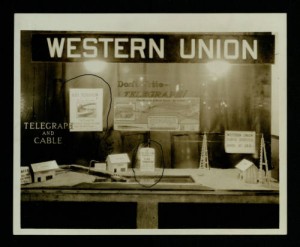
Naming campaign, Western Union storefront (1927) / from the USS Houston (CA-30) Photographs / (sign in window reads, “if you want a new cruiser named ‘U.S.S. Houston’ telegraph your congressman or the Secretary of the Navy”)
The recent publication of the USS Houston (CA-30) Photographs, adding to the growing Military History Collections at our Digital Library, marks another major milestone and means even more research potential for remote scholars unable to visit our rich USS Houston physical archives and materials.
Pulled from the photographs of the Cruiser Houston Collection, this new digital collection highlights the history of the heavy cruiser and her crew–the survivors, prisoners of war, and those who gave all. The flagship of the Asiatic Fleet during World War II, the Houston fought in the Battle of the Java Sea and to her bitter end at the Battle of Sunda Strait, sinking just after midnight as February turned into March, 1942. Highlights in the collection date back to the naming campaign that gave her our city’s name, include documentation of President Franklin D. Roosevelt’s affinity for the Houston as his vessel of choice for sea voyages and deep sea diversions during his presidency, show haunting scenes from those infamous POW camps, and testify to the resolve of 1,000 “Houston Volunteers” who answered the call sent out by the sinking of the Houston.
![Evacuation of POWs, Rat Buri, Thailand ([1945])](http://weblogs.lib.uh.edu/speccol/files/2014/09/evacuation_of_pows_rat_buri_thailand_1945-300x215.jpg)
Evacuation of POWs, Rat Buri, Thailand [1945] / from the USS Houston (CA-30) Photographs
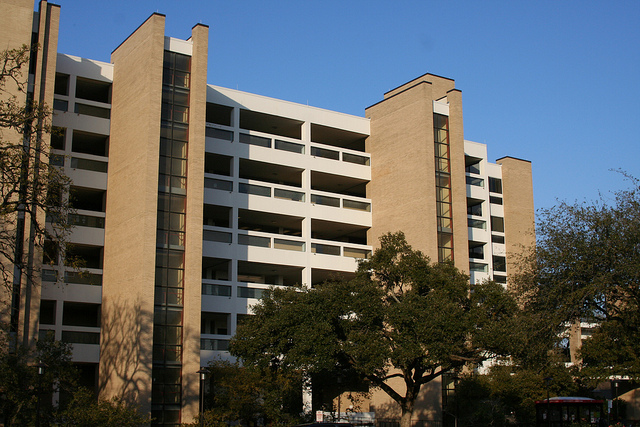
Kenneth E. Bentsen, Agnes Arnold Hall (1968), south elevation (Photo Eric E. Johnson, by permission)
In a recent post I analyzed the formal aspects of Agnes Arnold Hall. Like other buildings, it is a product of its time. Looking closely, we can see that Kenneth Bentsen interpreted some new ideas about composition and building layout that emerged in the early 1960s.
Agnes Arnold Hall owes more than a little to a well-known building at the University of Pennsylvania, the Richards Medical Research Building (1961) by Louis Kahn. The Richards was one of the most influential designs of the 1960s. Why? Prior to this, modern architects often expressed the building as a perfect geometric shape—usually a box and often a glass box. The usual practice was to place support services such as restrooms and stairwells in the center with the human occupants on the outside near the windows.
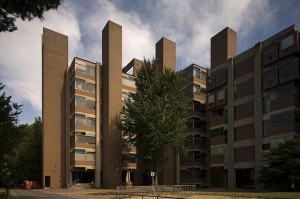
Louis I. Kahn, Richards Medical Research Building, University of Pennsylvania (Photo Richard Anderson by permission)
Kahn’s big breakthrough was to pull the support services out of the central core and place them on the outer edge of the building. There the services, housed in tall brick towers, became an important part of the building’s overall design (no more box!). Likewise, in Bentsen’s building the corridors, stairwells, and elevators are on the outside where they contribute to the design.
Agnes Arnold Hall also shows the influence of Paul Rudolph, another important architect of the period. He helped popularize the style known as “Brutalism,” with its monumental concrete buildings. Best-known was his Yale University Art & Architecture Building (1963).
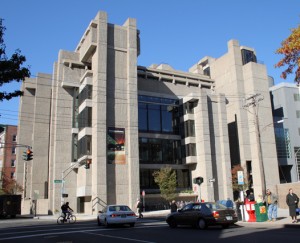
Paul Rudolph, Yale Art & Architecture Building (Photo Sage Ross, CC BY-SA 2.5)
Rudolph’s buildings were extremely complex. Occupants negotiated frequent level changes, as every floor seemed to be a mezzanine to another floor. The Yale A&A was said to have 37 different levels on 9 floors. And like Kahn’s building, some of the towers on the outside held stairs, elevators, and restrooms.
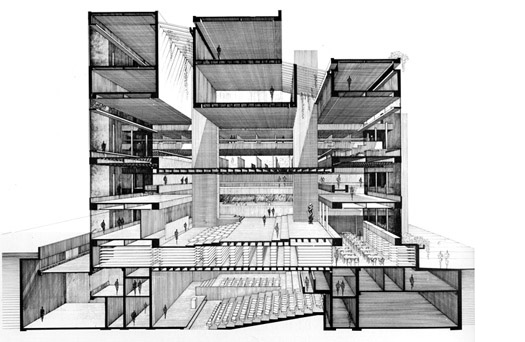
Yale Art & Architecture Building, section view (The Paul Rudolph Archive, Library of Congress)
In a small way you see some of this spatial complexity at Agnes Arnold Hall. Escalators (now stairs) thread their way through a four-story lobby area that is open to the outside. The lobby flows into an open courtyard at the basement level, and visitors enter the building over a bridge that spans this courtyard. But Rudolph’s influence is also apparent in the way the concrete is finished. Most of Bentsen’s building is faced in brick, but at the basement level the concrete retaining walls of the courtyard have what is called a “corduroy” finish. This was Rudolph’s trademark (look closely at the Yale building). After the concrete walls were poured and the forms removed, the workers attacked the surface with a jackhammer. Instant texture.
The Kenneth E Bentsen Architectural Papers, housed at the University of Houston Special Collections, are currently being processed.